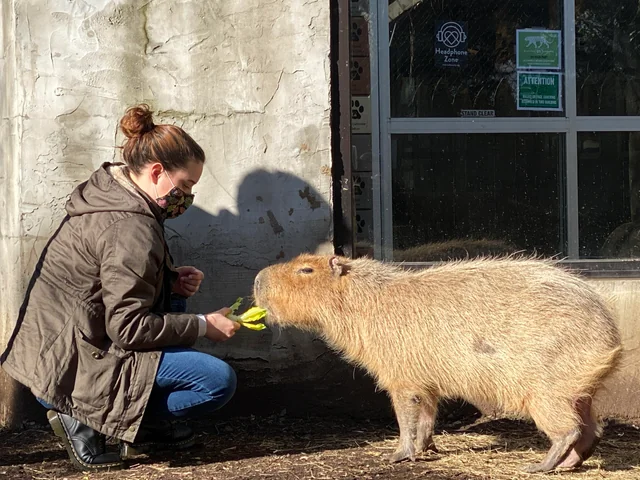Before getting a capybara, know that they require a large, secure outdoor space with access to water, a specialized diet, social companionship from other capybaras, and regular veterinary care from an exotic animal specialist.
Capybaras are undeniably adorable, with their gentle nature and goofy smiles. Their rising popularity as “giant guinea pigs” has tempted many to consider them as pets.
However, before bringing a capybara into your home, it’s crucial to understand the unique challenges and responsibilities that come with owning one of these semi-aquatic rodents.
Capybara: A Quick Introduction
| Feature | Description |
|---|---|
| Scientific Name | Hydrochoerus hydrochaeris |
| Family | Caviidae (same as guinea pigs) |
| Size | Largest rodent in the world, up to 4 feet long and 150 pounds |
| Habitat | South American grasslands and wetlands |
| Diet | Herbivore (grasses, aquatic plants) |
| Behavior | Highly social, live in groups of 10-20 (sometimes up to 100) |
| Lifespan | 8-10 years in the wild, up to 12 years in captivity |
| Conservation Status | Least Concern (currently not endangered) |
| Unique Features | Webbed feet, excellent swimmers, can hold breath underwater for up to 5 minutes |
| Temperament | Gentle, docile, friendly with other animals |
Here are 10 essential things you need to know before getting a capybara:
-
Capybaras are HUGE: These are the world’s largest rodents, reaching up to 150 pounds and 4 feet in length. They require ample space, both indoors and outdoors, to roam and explore.
-
They’re semi-aquatic: Capybaras love water and need a large pool or pond to swim, cool off, and even defecate. This water feature needs to be well-maintained and cleaned regularly to prevent health issues.
-
They’re highly social: Capybaras are incredibly social animals and thrive in groups. It’s recommended to have at least two capybaras, but the more, the merrier!
-
Diet is crucial: Their diet primarily consists of grass and aquatic plants. You’ll need a steady supply of fresh hay, vegetables, and access to safe grazing areas. Consult with a veterinarian specializing in exotic animals to ensure their dietary needs are met.
-
Veterinary care is specific: Not all vets are equipped to handle capybaras. Find a veterinarian with experience in exotic animals before bringing your capybara home. Regular checkups and vaccinations are essential.
-
Legal restrictions: Owning a capybara might be illegal or require permits in your area. Check local regulations thoroughly before making any commitments.
-
They’re not low-maintenance: Capybaras require daily attention, including feeding, cleaning their enclosure, and interacting with them to ensure their well-being. Be prepared to dedicate time and resources to their care.
-
They’re not house-trainable: While capybaras are relatively clean animals, they’re not house-trainable like dogs or cats. Expect to deal with droppings and urine in their living area, which will need frequent cleaning.
-
They have unique behaviors: Capybaras can be destructive if they’re bored or lack enrichment. They need plenty of space to roam, toys to play with, and opportunities to interact with other capybaras.
-
They’re a long-term commitment: Capybaras can live up to 12 years in captivity. Make sure you’re ready to provide a loving, stimulating environment for them throughout their lifetime.
If you’re willing to commit to the specialized care and resources that capybaras need, they can be incredibly rewarding companions. Their gentle nature, playful antics, and unique social behaviors make them a fascinating and enjoyable addition to the right home.



